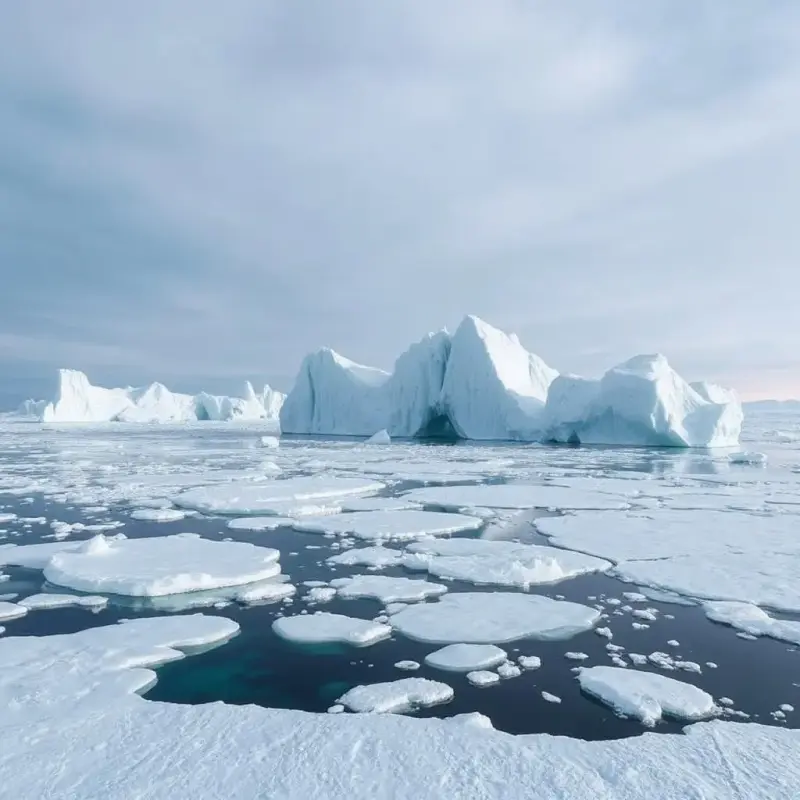Rare Devices for Investigating Arctic Ice Structures: Technological Contributions to Climate Change Research
The Arctic region, characterized by its vast expanses of sea ice and glaciers, plays a pivotal role in Earth's climate system. Understanding the intricate structures of Arctic ice is essential for comprehending the broader implications of climate change. Advancements in technology have led to the development of specialized instruments that enable scientists to study these ice structures with unprecedented precision. This article delves into some of these rare devices and examines how they enhance our understanding of climate dynamics.
1. Ice-Penetrating Radar (IPR)
Ice-penetrating radar is a crucial tool for examining the internal structures of ice sheets and glaciers. By emitting radio waves that penetrate ice and reflect off different layers, IPR provides detailed images of ice thickness, layering, and underlying bedrock topography. This information is vital for assessing ice volume and predicting potential contributions to sea-level changes. For instance, during the 11th Chinese National Arctic Research Expedition, ground-penetrating radar was employed to detect sea ice structures, aiding in the construction of acoustic velocity models.

2. Autonomous Underwater Vehicles (AUVs)
AUVs are robotic submarines designed to operate without real-time human control, making them ideal for exploring beneath ice-covered regions. Equipped with sensors and cameras, AUVs can map the seafloor, measure water properties, and observe ice thickness from below. NASA's deployment of robotic explorers in the Arctic to collect sea surface temperature data exemplifies the application of such technology in improving climate models.
3. Upward-Looking Sonar (ULS)
ULS instruments are deployed on the seafloor to measure ice draft—the portion of sea ice extending below the water surface. By continuously monitoring ice thickness, ULS provides data on sea ice volume and its seasonal variations. Advances in ULS technology have enhanced our ability to study changes in Arctic sea ice, offering insights into the processes driving these changes.
4. Ice Coring Drills
Extracting ice cores allows scientists to analyze trapped air bubbles and isotopic compositions, revealing historical climate data. Specialized drills are designed to penetrate deep into ice sheets, retrieving cores that provide records of past atmospheric conditions, temperature fluctuations, and greenhouse gas concentrations. These records are essential for understanding long-term climate trends and validating predictive models.
5. Remote Sensing Satellites
Satellites equipped with synthetic aperture radar (SAR) and other sensors enable large-scale monitoring of ice cover, movement, and surface melting. The RISAT-1 satellite, for example, utilizes compact polarimetry SAR imagery to classify sea ice, aiding in the characterization of Arctic sea ice.
Such remote sensing technologies provide comprehensive data that are crucial for tracking changes in ice extent and dynamics over time.
6. Autonomous Surface Vehicles (ASVs)
ASVs operate on the ocean surface, collecting data on sea ice properties, oceanographic conditions, and atmospheric parameters. Their ability to navigate through ice-covered waters makes them valuable for in situ observations, complementing data gathered from satellites and underwater vehicles. The integration of ASVs into Arctic research enhances the spatial and temporal resolution of climate data.
7. Ice Mass Balance Buoys (IMBs)
IMBs are deployed directly on sea ice to monitor changes in ice thickness and temperature profiles. They provide continuous, real-time data on ice growth and melt processes, contributing to a better understanding of sea ice dynamics. This information is critical for improving the accuracy of climate models and forecasts related to sea ice behavior.
8. Sub-Ice Observatories
Fixed platforms installed beneath ice shelves or sea ice enable long-term monitoring of ice-ocean interactions. These observatories measure parameters such as water temperature, salinity, and currents, which are essential for understanding the processes driving ice melt and formation. Data from sub-ice observatories inform models that predict the response of ice masses to changing ocean conditions.
9. High-Resolution Seismic Sensors
Seismic sensors detect and analyze vibrations within ice, providing insights into ice dynamics, including cracking, movement, and interactions with underlying bedrock. This information is vital for assessing the stability of ice structures and predicting potential calving events. High-resolution seismic data enhance our understanding of the mechanical behavior of ice in response to environmental changes.
10. Laser Altimeters
Mounted on aircraft or satellites, laser altimeters measure the elevation of ice surfaces with high precision. By detecting changes in ice elevation over time, scientists can infer patterns of ice accumulation and loss. This technology is crucial for monitoring glacier dynamics and assessing contributions to sea-level changes.
Integration of Technologies in Climate Change Research
The combination of these specialized instruments allows for a comprehensive approach to studying Arctic ice structures. For example, the Multidisciplinary drifting Observatory for the Study of Arctic Climate (MOSAiC) expedition utilized a suite of these technologies to investigate the complex climate processes in the Central Arctic.
By integrating data from various sources, researchers can develop more accurate models to predict future climate scenarios and inform global climate policies.
Challenges and Future Directions
Despite technological advancements, challenges remain in Arctic research. Harsh environmental conditions, logistical constraints, and the need for international collaboration pose significant hurdles. However, ongoing innovation continues to enhance the resilience and capabilities of research instruments. Future developments may include the deployment of more robust autonomous systems, improved remote sensing techniques, and enhanced data integration methods.
Conclusion
Technological advancements are revolutionizing our understanding of Arctic ice structures and their role in global climate dynamics. From ice-penetrating radars to AI-driven data analysis, these tools are enabling researchers to study the Arctic with unparalleled precision and depth. However, the challenges posed by climate change demand not only innovative technologies but also global collaboration and sustained investment in Arctic research. By continuing to push the boundaries of what is possible, we can deepen our understanding of the Arctic and develop strategies to protect this vital region for future generations.
This combination of cutting-edge devices and collaborative efforts represents a beacon of hope in addressing the challenges posed by climate change, ensuring that the Arctic continues to play its critical role in the Earth’s climate system.
Articles
Opt-in for our updates to receive the latest and most fascinating articles right in your inbox.